Wildflowers, Grasses and Other Nonwoody Plants
Media
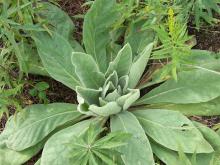
Species Types
Scientific Name
Verbascum thapsus
Description
Mullein immigrated to America along with Europeans, and with them it has spread across the continent. Its fuzzy, green-gray rosettes of leaves and tall spikes of yellow flowers make it easy to identify.
Media
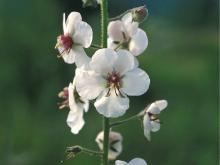
Species Types
Scientific Name
Verbascum blattaria
Description
Moth mullein is a native of Eurasia introduced to our continent in the early 1800s. Since then, it has spread across North America. It’s named because the fuzzy flower, with 2 antennalike stamens, looks something like a moth.
Media

Species Types
Scientific Name
Phemeranthus calycinus (formerly Talinum calycinum)
Description
Rock pink is a succulent perennial with slender, naked flower stalks and bright magenta flowers that usually don't open until after noon. Leaves are basal and fleshy, to 2 inches long. Look for this plant in glades and other hot, dry, rocky places.
Media

Species Types
Scientific Name
Anemone canadensis
Description
White anemone is a showy native wildflower with interesting, deeply toothed leaves. Often occurring in colonies, it spreads easily (even aggressively) from rhizomes and is sometimes cultivated in wildflower gardens.
Media

Species Types
Scientific Name
Thalictrum thalictroides
Description
Rue anemone is a common and beloved spring wildflower. It blooms March–June. It and other woodland wildflowers require a forest habitat to survive, so they depend on the oaks, hickories, maples, and other trees that surround them.
Media
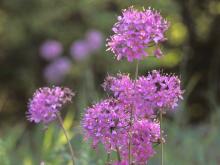
Species Types
Scientific Name
Allium stellatum
Description
Wild onion is edible and is also favored by native-plant gardeners, who enjoy its showy umbels of pink flowers and tolerance of dry, rocky sites. This Ozark species blooms in summer and fall.
Media
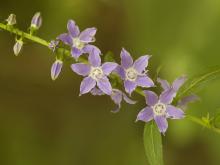
Species Types
Scientific Name
Campanula americana
Description
Tall bellflower is an abundant native bellflower that is easily identified by its stout, tall habit, short, wheel-shaped, blue corolla, and the curved, purple style that projects beyond the flower.
Media

Species Types
Scientific Name
Ageratina altissima (formerly Eupatorium rugosum)
Description
White snakeroot looks very similar to thoroughworts, but it has triangular leaf blades that are more broadly angled or rounded at the base. White snakeroot is common statewide. It’s a toxic plant if eaten, so it’s good to be able to identify it.
Media
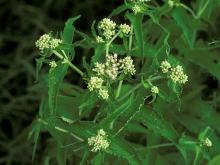
Species Types
Scientific Name
Eupatorium perfoliatum
Description
American, or common boneset has small, white flowerheads in flat-topped clusters at the top of the plant. The leaves are hairy, narrowly triangular, and in opposite pairs fused around the stem.
Media
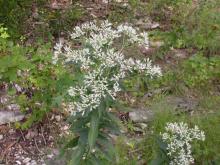
Species Types
Scientific Name
Eupatorium altissimum
Description
A stout perennial that can grow to 6 feet tall, tall thoroughwort is a member of the sunflower family that has dull white flowers and distinctive leaves that are opposite, slender, very short-stalked, and with three quite noticeable veins.
See Also
About Wildflowers, Grasses and Other Nonwoody Plants in Missouri
A very simple way of thinking about the green world is to divide the vascular plants into two groups: woody and nonwoody (or herbaceous). But this is an artificial division; many plant families include some species that are woody and some that are not. The diversity of nonwoody vascular plants is staggering! Think of all the ferns, grasses, sedges, lilies, peas, sunflowers, nightshades, milkweeds, mustards, mints, and mallows — weeds and wildflowers — and many more!





















